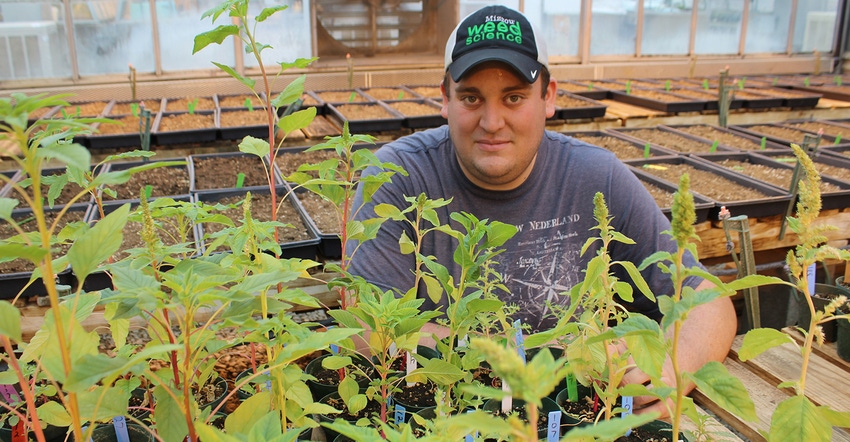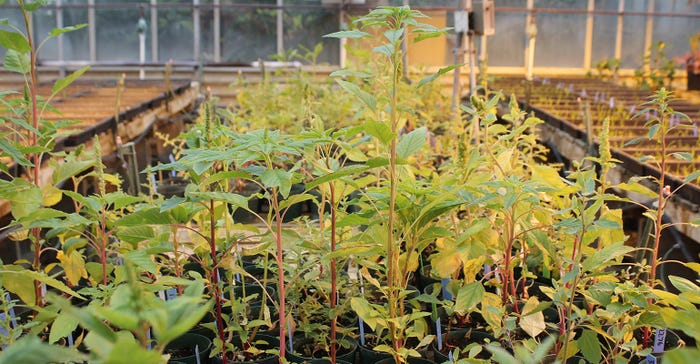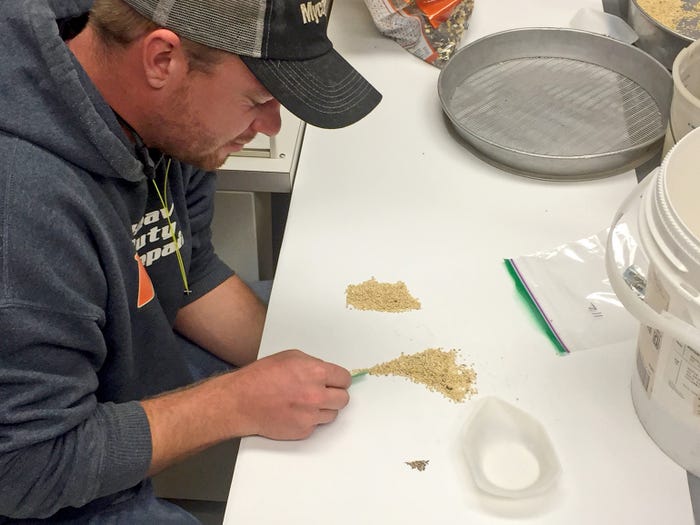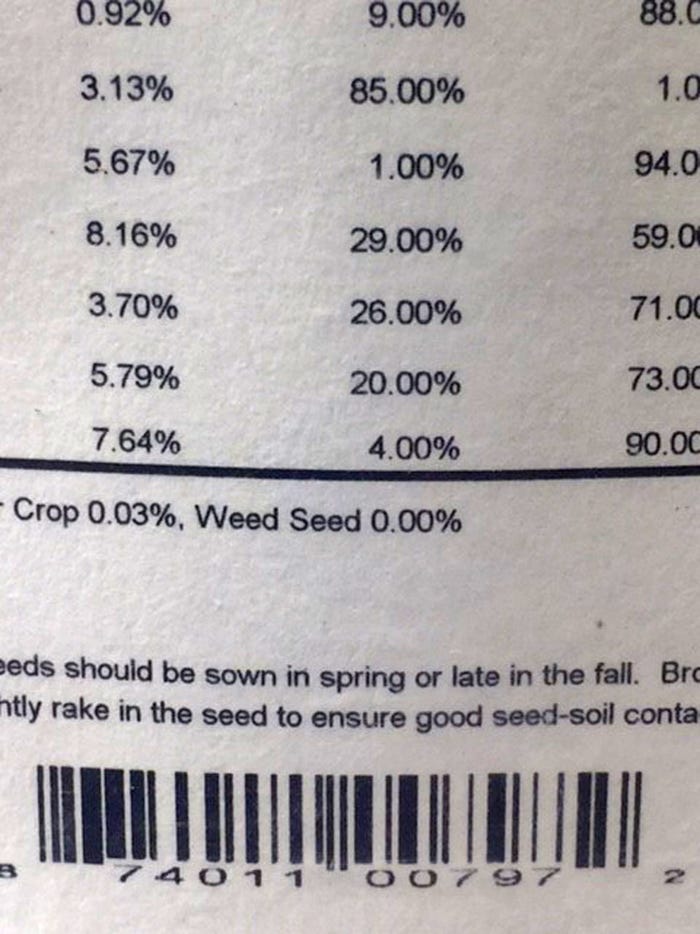
A warm yellow glow fills the greenhouse just off Ashland Road on the campus of the University of Missouri, Columbia. Eric Oseland leans over a table and inspects the leaves of a plant. "This is a Palmer amaranth," he says. As his eyes span the entire length of the table, he adds, "They are all pigweeds, many waterhemp and Palmer." It is hard for the MU graduate student to imagine what is before his eyes since he planted the seed from pollinator mixes with the tag reading "Weed seed: 0.00%."
Oseland, who works under MU weed scientist Kevin Bradley, started his research project on the presence of weed seed in pollinator mixes last September. "We were hearing about Palmer amaranth showing up in Iowa CRP [Conservation Reserve Program] acres and decided to start looking at pollinator mixes as a potential source," he explains. So Oseland, an Illinois native, took to the internet and started purchasing pollinator seed mixes from various companies and states.
He focused on 15 pollinator mixes. Along with fellow students, Oseland sifted through the mixes and identified the weed seeds. "You cannot tell just by looking at a seed what type of pigweed it is," he notes, "you just know it is a pigweed seed." To determine the species, Oseland planted the seeds.
What he found was that of the 15 mixes, nine had the presence of pigweed; and of those mixes, one has been confirmed to include Palmer amaranth.

WEED WATCH: There were many different species of weeds in pollinator mixes. MU researchers are most concerned with Palmer amaranth. Sowing this into CRP acres can create control problems for landowners if left unchecked — one plant can produce 1 million weed seeds.

Why worry about Palmer amaranth?
Palmer amaranth is the No. 1 weed to watch in the U.S., says Bradley.
One plant can produce up to 1 million seeds. Palmer amaranth seeds are about the size of a pinhead, not unlike some other native seeds found in common CRP mixes. These seeds can live in the soil for up to five years and remain viable.
In years past, weed seed entered farms and pastures through farm equipment, animal feed and animal bedding. MU research also found waterfowl could spread weed seed. Oseland says pollinator mixes add to the growing number of ways that Palmer amaranth spreads.

DIFFICULT TO DIFFERENTIATE: Shea Farrell, a graduate student at the MU Division of Plant Sciences, checks pollinator seed mixes for Palmer amaranth seed. These tiny weed seeds are often similar to native seeds. (Photo by Eric Oseland)

So far, Missouri has not seen quite the outbreak found in other states. To date, Bradley knows of just one site in Missouri that was likely planted to a contaminated pollinator mix. "We will look at it in the summer to see what comes up."
Iowa was hit the hardest, as landowners planted more than 100,000 acres to native seed mixes. The state went from five counties reporting Palmer amaranth to 46 in just one year. States like Indiana, Ohio, Illinois and Minnesota also reported contaminated seed issues, but to a lesser degree.
"It is quite a situation going on," Bradley says. "Most of the seed tags say '0.00% weed seed.'"
Monitoring seed rules
The Federal Seed Act requires that corn and soybean seed companies label each seed bag. CRP seed providers are also required to list the same type of information, including what species is in the bag, percent of pure seed, percent of weed seed present, percent of inert matter and germination rate.
Still, as MU research found, some weeds are slipping through inspections. "The whole industry does not seem to be as tightly regulated," Bradley says. "Not like corn, soybeans or wheat." He says right now, there is more confidence in a seed tag on a corn or soybean bag than a pollinator mix.

NOT WEED-FREE: Not all tags are truthful. The MU Division of Plant Sciences is researching pollinator mixes as a source for spreading Palmer amaranth on CRP acres.

Missouri does have its own state seed inspection. The Missouri Department of Agriculture Bureau of Feed, Seed and Treated Timber enforces the laws and regulations to ensure that agricultural, vegetable and lawn seeds are labeled consistently and accurately. According to the state law, each agriculture or vegetable seed label must include a total percentage of germination, and also of purity, which includes the total of pure crop seed, other crop seed, inert material and weed seed.
"What we regulate in our office is the Missouri commercial seed law, and it does not cover flowers," says Jacob Fleig, program coordinator with the Missouri Department of Agriculture Plant Industries Division. "Wildflower mixes are not covered under our law."
What's a farmer to do?
With little enforcement in federal law and lack of coverage by state seed laws, farmers are left to police their own pollinator mixes.
Jerry Kaiser, USDA Natural Resource Conservation Service plant materials specialist, says farmers can send mix samples in for testing. "If a seed test shows pigweed, then that pigweed species is grown out in a lab to identify which species of pigweed it is," he says.
However, if the seed is already in the ground, this summer farmers will be able to spot Palmer amaranth. Palmer grows quickly over other pollinator species, Kaiser says — up to 3 inches per day.
If landowners spot only a few plants in fields, they may elect to remove them by hand, with a hoe. If a large number of weeds are present, Kaiser says farmers can use herbicides to spot-spray. "This will control the weed without destroying other pollinator plants."
Whatever the method of choice to stop the spread of Palmer amaranth, control is critical. Bradley sums it up this way: "Any seed, feed or equipment coming onto your farm should be thoroughly examined for the presence — or even the possibility — of Palmer amaranth seed."
About the Author(s)
You May Also Like




